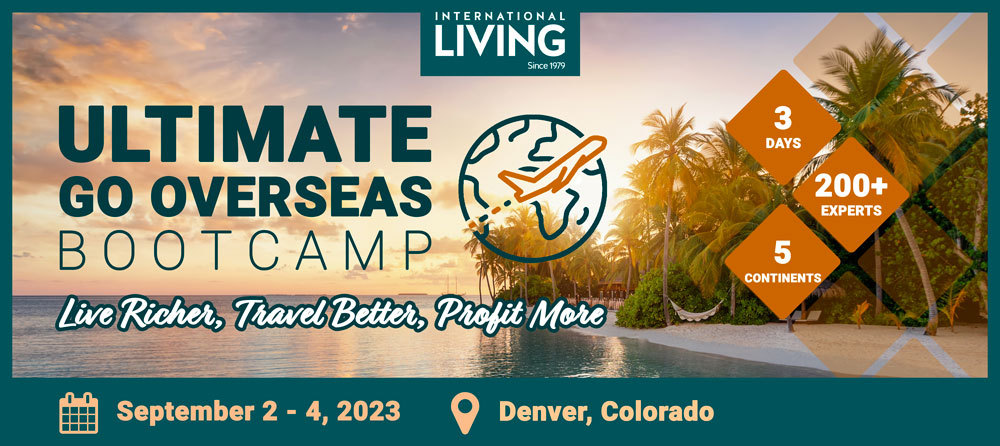Always wanted to live in a foreign country but not sure how to go about it?
We get it. There are nearly 200 countries in the world to choose from. And while some are surely “no go” places you wouldn’t want to live, there are dozens and dozens of places where you could happily thrive.
So how do you decide where to go? And how do you make it happen?
A lot of our correspondents and contributors went on retirement scouting trips before making the big move overseas. It takes time to learn which country, and even what town or city within that country, is your best fit. Below they share their experiences and what valuable lessons they learned:
 Donna Stiteler, IL contributor in Cuenca
Donna Stiteler, IL contributor in Cuenca
I always tell people that not going on an exploratory trip is like having unsafe sex, nine months later you may be sorry. We all took the same journey when exploring our future in Ecuador, but in different ways. My friend Sandy brought a checklist and approached the exploratory trip like she was studying for the bar exam. Whereas Stefani skipped the exploratory trip and came sight unseen carrying two large suitcases. We all got the same results, no matter how we explored Cuenca. It was the spot that “just felt right.”
My exploratory trip was more serendipity than planned. It was 2014 and I was looking for a place to provide respite from my high-stress job, one that gave me the economic freedom to retire early and bring adventure back into my life. And as the plane circled Cuenca’s red-tiled roofs and I spotted the three baby blue domes of the New Cathedral, I thought maybe this is the place I’m supposed to be.
I was lucky enough to work in South America giving microloans to women in developing countries to start their own businesses. I had seen glass shards topping concrete walls, black bars covering windows, and walls scrawled with graffiti. But I had also watched children playing by their parents’ sides in small tiendas. I understood when shops unexpectedly closed so parents could watch their kids’ soccer matches. I loved the Ecuadorian culture, one unincumbered with material things, where families lived side by side, and Sundays were for church and suppers surrounded by loved ones.
It wasn’t unlike my life in Florida where I lived among my own tight-knit clan, before my world started leaning toward acquiring things and skipping memories. It was a world where Sunday dinners disappeared as we busied our lives, but I never thought I would actually move abroad.
That changed when I went on a press junket to Ecuador and found a place that took me back to when my life was simple. We toured all over Ecuador–to the parrot-stocked rainforests in Mindo, around the towering mountains of the Avenue of the Volcanoes, to modern and bustling Quito, and to the textile markets in Otavalo. Ecuador was by far the friendliest place I’d traveled to. Everyone smiled and greeted each other with “Buenos Dias”. Could this be my next home?
I started reading International Living and studying Ecuador, but seeing things on paper is nothing like dipping your toes in a new place. I decided to do an exploratory trip to start planning a future instead of just stumbling through life. Nothing compares to the glee I had when I happily handed in my resignation and felt the heavy burden of my old life lift. Two months later, I was on my way back to Ecuador for a three-week exploratory trip.
The minute I stepped off the plane in Cuenca, it was as if my Irish DNA synched. The cool climate made my skin feel refreshed, replacing the sweltering heat of Florida. I found solace in the surrounding mountains which reminded me of how small I really am in the scheme of things. I relaxed and felt safe.
I booked a room at Ordonez Hotel, a large Ecuadorian hacienda where the owner spoke English and helped guide me to must-see places. The first day, I ventured out alone and stayed lost in the city for hours taking in the Spanish colonial and French republican architecture that earned Cuenca it’s UNESCO Heritage Site designation. I bought long stem roses at the flower market for $3 from an indigenous woman talking on her iPhone. I wandered through San Francisco’s market and bought an alpaca blanket for the cool nights. And I learned that Cuenca, a city that draws hordes of tourists and gap-year backpackers, was not only composed of indigenous people selling fruits from wheelbarrows, but also very modern. A place one step backward in time, and two steps forwards into the future.
On my third day walking downtown, I met Yogi, a poodle mix, who was leashed to Bob and Stefani Owens. We gabbed for a long time and the Owens invited me to get to know the city with them. Together we walked through El Centro’s downtown, with Stefani unraveling the mysteries of how to live in Ecuadorian culture, pointing out good restaurants to meet expats, and stores to buy fresh cheese and baskets full of hot bread.
After a week of playing tourist and meeting other expats who welcomed me with information and cautions, it was time for me to start actually planning. To get to know the neighborhoods, I hired an English-speaking driver for $20 to spend the day taking me to potential places to settle. There was San Joaquin, a suburb surrounded by farmland; Gringolandia, an expat enclave with towering modern condos; and El Vergel, an upscale, uptown neighborhood filled with college students and families playing in Parque de Madre.
I found a house with a yard suitable for me and my five dogs, and I signed my lease with my landlord Raoul on a paper napkin for a five-bedroom, four-bathroom house with a small yard renting for a mere $400. Pinning down a home before actually moving made the dream of retiring abroad a reality for me.
I also met with a visa facilitator and put down $1,000 to start on my permanent residency so, by the time I moved to Ecuador a few months later, I had all the paperwork needed to file.
I was working remotely freelancing at the time and Raoul helped me set up fiber-optic internet to support my remote job and I felt relieved the first time I logged into my computer and connected to the world. He set up my television to get Netflix, Prime Video, and Hulu so I could watch my favorite television shows, which made me feel more at home.
Raoul drove me around town to show me the best places to buy meat, and to the three-story modern Mall del Rio with a food court to chow down on Big Macs and KFC. On Sunday, I went to Raoul’s church, where I sat among Ecuadorians singing familiar songs in Spanish and listened to a three-hour sermon, which gratefully ended with a barrage of roasted pork, fried plantains, and sweet mango cake.
On my exploratory trip I got to feel the city. I learned there would be a way to build a community of friends so I wouldn’t be alone. The climate allowed me to spend long days wandering around the town and walk myself back to health.
Cuenca created a happiness in me. Nightly fireworks sparkled in the sky. Women danced in long, velvet, embroidered skirts in non-stop parades. Families gathered in Parque Calderon sharing ice cream cones. Ecuador provided a simple life where I could restore what was lost and live again.
I found I could have two homes. In Florida, I have the love of my family and lifelong friends. But in Ecuador, I found respite and, eventually, myself.
It was that first step off the plane in Cuenca that was my “aha” moment. When the cool air hit my face, it “felt right.” And really, on an exploratory trip, that’s what you should be looking for.
WIN YOUR DREAM RETIREMENT OVERSEAS
 Kathleen Evans, IL contributor in Costa Rica
Kathleen Evans, IL contributor in Costa Rica
I grew up in a household where we had regular “family meetings” presided by my father. In the early days, it was a dictatorship, but as his offspring grew older, it became closer to democracy, giving all attendees a voice. We covered financial planning and banking, social and educational scheduling, vacations, problem-solving, etc. It wasn’t as horrible as you might be thinking…okay, sometimes it was. But ultimately, what I learned from these meetings helped develop my foundation for living overseas successfully.
An international traveler at heart, I loved exploring and researching at a young age. So, it was no surprise to anyone, after a semester abroad and an introduction to International Living magazine 30+ years ago, that I began subscribing and imagining the possibilities of creating an expat lifestyle for myself. My husband and I added time for researching possible retirement destinations when we vacationed. If we unanimously answered “Yes” to “Could I live here?” that was all it took to set the wheels in motion while on the ground there. We would meet with a real estate professional and look at properties for sale within our rough budget. We looked at rental prices and food costs at the local grocery store or market. We stopped in the hardware store and pharmacy. We frequented expat hangouts and talked to people who had already made the move. It was important to hear not only why they loved it there, but also their frustrations.
In the early days, it was mostly recon while we were already on vacation. We had careers that kept us tied to the U.S. We were young and there was no internet or “digital nomad” lifestyle back then. In fact, if you were an expat and you were not working for a company that sent you overseas, many people assumed you were running from something—finding some jungle in which to hide out. The initial countries we investigated were Mexico, Greece, and a number of islands, including Barbados, The Bahamas, Aruba, and St. Kitts/Nevis. Due to expenses, and less-than-optimal flight options, none of them made the cut, except Mexico.
After reading several articles about property and lifestyles in Belize, we also took a serious trip there to explore the atmosphere—being especially drawn to “cheap” prices and English as the official language. We traveled in September—notoriously one of the worst rain months. It is recommended to not only see a place at its best, but also during its worst to see if you could actually “live” there. As it turned out, we couldn’t.
After a couple of purely recreational holiday trips to Costa Rica, we decided we should put this Central American dynamo on our retirement radar. Initially agreeing that the weather was perfect for us, the scenery was spectacular, and the locals seemed warm and welcoming. In early 2008 we found ourselves inching closer towards the big 5-0 and completely burned out mentally and (in my husband’s case) physically with our exhausting careers. I remember that moment, sitting in our kitchen having a glass of wine. “Are we going to get serious about this early retirement thing or are we just going to keep looking forever?” he asked me. Reminiscent of the old Evans’ family meetings, I donned my imaginary dictator crown, pulled out a notepad, and jumped into action. “Let’s make a list of what we want the second half of our life to offer. What is a deal-breaker? What can we live with?” I smiled, visualizing life on a beach someplace, tropical breeze blowing through my hair.
Obviously, everyone will have a different list, depending on what is important to you. Ours looked like this:
- See and hear the ocean every day
- Never wear a coat again
- Ease of travel/affordability back and forth to the U.S.
- Ability to buy/own property or a business with a clear title as foreigners
- A straightforward residency process for which we would qualify without a pension
- Access to good/affordable healthcare
- An overall lower cost of living than in the U.S.
- A stable democracy
- A social community with a variety of things to do
- No quarantine for our dog to enter
- Ability to drink water safely out of the tap
- English is widely spoken (bonus, but not a deal-breaker)
We quickly booked a trip back to Costa Rica. We liked what we saw on the Central Pacific coast. A vibrant beach region with all the basic amenities and just 1.5 hours to the capital, San Jose, for all the major commerce and healthcare. We found several properties that worked for our lifestyle and realized that Costa Rica did indeed meet every bullet point on our list. But then that pesky housing crash happened. And the “catalyst home” we had listed to sell, didn’t.
When making major decisions about moving your entire life to a foreign country, it is not uncommon to get cold feet during the process. If it has happened to you, don’t stress. After all, some of your friends and family are, most likely, saying you’re crazy. You are going to miss your kids/grandkids. You are not sure you can find a healthcare provider as good as the doctor you love. What if you find the language to be too challenging? All valid concerns. This was about the time I got cold feet.
In 2010, with a plan in limbo and a home unsold, we traveled to Panama, another country meeting our criteria. In fact, even more so because they use the U.S. dollar–zero concerns for monetary instability. I could see how one might love it there as we explored in and around Panama City. However, our hearts by then were in Costa Rica. At the urging of a friend who owned some land in Guanacaste, we next traveled to the Gold Coast area. We spent three different weeks there over the next two years, scouring properties and forging local relationships. It met our entire criteria list. We felt the magic on our first trip–that feeling when your heart beats a little faster and you know you could call it “home”.
The catalyst house sold in early 2013 and the whirlwind year began… Selling/storing/donating everything in our lives, preparing a place to rent first before confirming we wanted to buy, working on residency paperwork, buying a car, ultimately purchasing a condo in the building where we rented, and sending off our shipping container in November–WHEW! Now, over eight years later, I can truly say it was the sheer number of scouting trips and staying true to what we wanted on our criteria list that has made expat life a success.
 Laura Diffendal, IL contributor in Belize
Laura Diffendal, IL contributor in Belize
Back in 2013, after my first trip to Central America, I was hooked right away. The exotic feel of simply driving, shopping for groceries, and seeing the ocean and lush jungle while walking down the street, not to mention the vast opportunities available for starting a business or buying an existing business, and the endless side trips to enjoy… all of it played a part in making me want to live that feeling full time. It seemed like so much of life was on autopilot in my normal suburban routine, and when you are somewhere that feels so out of the norm and intense, you become mindful again of enjoying each moment. After my return from my first trip to the area, I researched non-stop to see if moving to Central America full time was even a remote possibility.
As I am years from retiring, my husband and I had to choose somewhere where we could buy a business. Belize for us was perfect—English speaking, friendly to expats, exotic but mixed with enough North American touches that we felt at home, yet still with the awareness that we were living somewhere special.
Although we researched for a year before visiting, we still did the thing that everyone says not to do—make an offer to buy real estate on your first trip somewhere! We did just that: We planned a whirlwind trip to Belize where we visited Ambergris Caye, Caye Caulker, Corozal, Cayo, Hopkins, and Placencia, bidding on places in Ambergris Caye and Placencia. We got an accepted offer in Placencia and, about 45 days later, we packed up our lives in the U.S. and moved to Belize, never looking back!
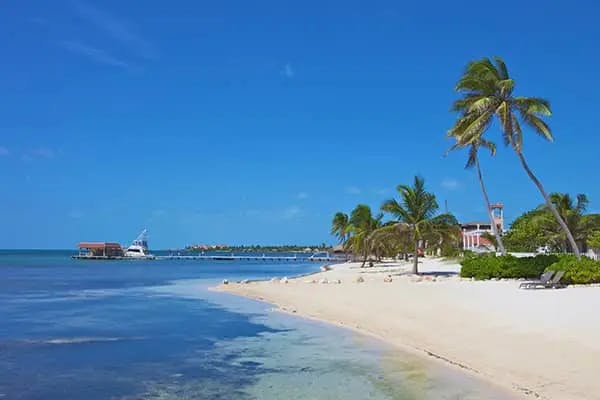
We have visited other places where we didn’t buy real estate right away, and I have been asked a lot about why Belize: How did we know after one visit that this would be right for us? What set it apart from other places we had visited? The answer to this is definitely that, by the time we had visited, I had done so much research it already felt somewhat familiar. There is also a magical feeling of “rightness” about some places when you visit—the pace, culture, and overall feeling of being at home, at peace. We had that feeling both in Ambergris Caye and in Placencia. The mix of authentic local culture with the energy and growth of the tourism market, the beach community, and fun expat culture were present in both places and we couldn’t get enough of it. Eventually, we grew businesses in both places and we now get to live part-time in both!
Although this is not for everyone, for me, I needed to fully commit by ripping up roots in the U.S. and not having that as a safety net to fall back on. It would have been too easy when hitting the first inevitable roadblock to give up and return to what is normal and comfortable. We had no choice but to move forward and use all our grit as we were solidly committed, like it or not! Other people take a reasonable stance of living for six months in a new place, trying it on for size. There are pros and cons to both. In any new place, you are going to hit times where you face inevitable challenges, both big and small, and it is important to know yourself and to set yourself up for success. For some people this might mean diving right in, for others this might mean wading in.
We have realized a few things over the years that have definitely shaped our positive experience as expats. One of the most important tips for overall happiness is knowing what to expect, even under the best of circumstances. After a while in a new country, even if overall you are happy there, you will experience a cultural fatigue, and it can come out of nowhere for some. Spending time back in your home country can definitely help balance and keep a perspective. Every expat I have ever talked to has experienced this feeling—it is a feeling similar to burnout and if you do not take a break from your new home, you may mistake it as being a reason to leave. Those that see it for what it is and expect it are ready to work through it as part of the transition. It usually happens within the first year or so. There isn’t anything one can do to prevent it either! This goes back to our case—we were ready for it, and we had prepared by knowing there was no turning back and we had to make it work. That phase didn’t last long and now, over seven years later, Belize feels like home.
It can be overwhelming to pick a new home, so it can be much more manageable to narrow your choices down to three places. International Living is a great place to help you do your research. I used them before I ever wrote for them and it helped me in the “information gathering” phase to figure out what kind of place I wanted—big city, beach town, distance from U.S., expat experience etc. This is the fun part! The “exploration phase”, the travel and the discovery of each new place and seeing if it is the fit, is such a great example of the journey being the experience.
 Valerie Fortney-Schneider, IL Italy Correspondent
Valerie Fortney-Schneider, IL Italy Correspondent
Maybe we did it all wrong. We didn’t do a scouting trip or line up a contract on an apartment before we landed in Rome, seven duffels and suitcases in tow. Now, don’t get me wrong: our move to Italy certainly wasn’t spontaneous, but we didn’t plan everything down to the minute details, either. (We also later bought a house over the phone with no money down, but that’s a story for another time.) When we made the big move, we didn’t have anything set in stone in terms of long-term location and rental lease, basically because we didn’t have to.
We had the extreme good fortune of having Roman friends who lent us their beach house in Anzio, giving us not just a place to live but also the luxury of leisurely looking around, rent-free. The generous gesture both helped and hindered our search for “home” in Italy.
We had first traveled to Italy in 1996, and that starry-eyed visit had us hooked. We returned again and again, making each trip longer. We started staying a week or more in one place to “try it on for size” and employ a “slow travel” approach instead of running up and down the length of the boot in a single trip. We then started settling in and paying attention, not as tourists but as “locals”–taking a better look at what it would be like to live in Italy. We did everyday things like going to the market, getting a haircut, shopping in the little local hardware store. In one town, we even sought out the arrotino to sharpen the dreadfully dull knives in the apartment we’d rented! We perused the real estate listing magazines, gazed in the windows at the tacked-up rental offerings in agencies, and hit as many hill towns as could in each day. Yes, we have a thing for historic hill towns and castles.
What we failed to do was fall unequivocally in love with one single place. We could picture ourselves happy in Italy; we just hadn’t focused our attention on a particular town or region. We had some ideas, of course, but hadn’t set our sights on a determined destination yet. That didn’t stop us from moving forward, mainly because we had a place to live and, as our friends pointed out, we could take our time, get our bureaucratic ducks in a row with their help, and start learning the language while looking for a town that called our names.
Our friends welcomed us in, coming down for weekends from their home in Rome to be together, assist in the paperwork, show us the ins and outs of the bus system, where to find the best fresh fish (the docks as the fishermen come back, in case you’re wondering for future reference), where the best weekly market is, how to compare cell phone plans, and dozens of other necessary details. We spent the first weeks taking walks on the beach just a block away, getting familiar with the city, trying to communicate, and looking at books, maps, and online resources to work through a list of places we wanted to look at for our home base. The problem, of course, is Italy is so rich in beautiful towns that we liked one after another, and with our cozy little house and lemon-scented yard near the sea as lodgings, the search continued.
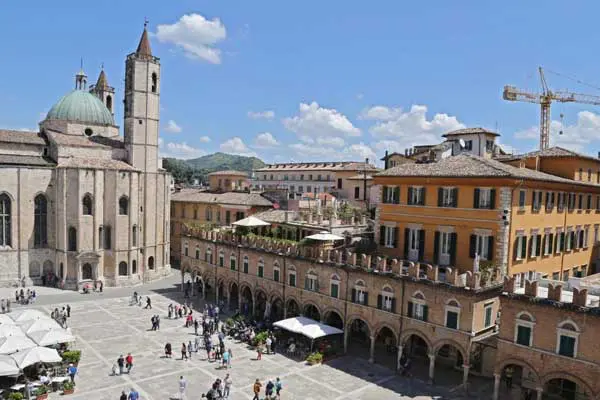
We traveled to the city of Ascoli Piceno in Le Marche to study Italian in what can only be described as “language school boot camp.” We had selected it specifically because it was a little-known destination where few people would speak English to us automatically, as we found so often in Rome and Florence. Instead, there we would have to use the language and immediately put into practice the lessons we were sweating over daily—literally. It was July and extremely hot, but the nearly three weeks of intensive classes gave us a good jump-start on our comprehension and speaking skills, and also convinced us that Ascoli Piceno was a beautiful, vibrant, and livable city. The travertine-clad buildings and piazzas, the sense of vitality in the events and evening passeggiatas we experienced, and the ease of getting around all grabbed us, and the few weeks we spent there made us feel at home.
We returned to Anzio and looked at a few more places on our list in the Lazio region, but Ascoli Piceno was the clear winner in our minds. We broke the news to our friends, but still needed to find an apartment, just as August was dawning, bringing the annual shut-down of nearly all normal business.
Italy tip: Don’t ever try to conduct business in August. The rental agencies didn’t respond; “by owner” listings in the local classifieds paper we’d taken back with us resulted in endlessly ringing phones to no answer, as everyone went on holiday. So, we did, too; since we were already at a beach destination, we settled into the rhythm of the Romans who flocked down from the city, being taken in on the tailcoats of our friends to parties, barbecues, dances, and movie premiers. It was a sort of Twilight Zone experience, to be honest, this total halt to normal daily life for weeks, but also a nice introduction to the “real” Italian immersion experience. We went with the flow, and gained a lot of insights, memories, and good times from it.
We returned to Ascoli to find an apartment, resorting to walking the narrow lanes and looking for affittasi (for rent) signs on doors and calling the numbers. We lucked out and found a sweet casa just a few blocks from the main piazzas and even sweeter owners who took us in as part of their extended family. The overwhelming hospitality of the Italian people should never be underestimated. We enjoyed the ambiance and liveliness of Ascoli for about two years, before leaving for points south, feeling the pull of my family ties in the region of Basilicata.
We still feel at home when we visit Ascoli Piceno, but decided to make our home—and purchase a home—in my ancestral region, where the timeless rhythm of life drums out the seasons, where a village makes every day personal, where the mountain splendor is our balcony view, and where life is low-key and tranquil. It doesn’t hurt that I have cousins nearby, that the cost of living is very affordable, and that we enjoy the mountains while being within an hour’s reach of two seas.
Do I recommend a scouting trip? Absolutely! Especially if you’ve not spent any extended time in your preferred destination, it helps to see a place more in-depth, from the inside out. The visa applications in Italy now also require a rental contract or house title, instead of a letter from friends like we had back then. Would I change any of our journey? Not a chance. We cherish every experience we had along our winding road to home.
WIN YOUR DREAM RETIREMENT OVERSEAS
 Jason Holland, IL Roving Latin America Editor
Jason Holland, IL Roving Latin America Editor
The first time I moved abroad, with my wife (pregnant at the time), four-year-old son, and two dogs, we went about it all wrong.
We had visited Costa Rica in 2005 as newlyweds and bused around the country with our backpacks, staying in rustic eco-lodges around Lake Arenal and cabinas by the beach in the Southern Zone. It was a trip of a lifetime as we spent our days bird watching, zip lining, and hiking through unspoiled rainforest. That was the beginning of our love for Costa Rica’s natural beauty, friendly people, and laidback lifestyle. We returned as parents of a young child in 2010, this time renting an SUV so we could explore even more. Again, we really enjoyed everything the country had to offer.
When we decided, in 2012, to leave Florida and move abroad, Costa Rica was at the top of our list. In fact, we didn’t consider any other destination. From that decision to the actual move was about three months. We did a ton of online research. We got in touch with some people there we knew and peppered them with questions. And, over a period of months, we sold, gave away, or stored a house full of stuff.
We also found an OB/GYN for my wife and rented a home within 45 minutes’ drive of the hospital. Although…it was in a town we’d only ever passed through for about 10 minutes during our epic road trip two years previously.
We thought we were pretty well prepared. We thought we knew what we were getting into. And that if something unexpected came up, we could handle it. Things did turn out okay in the end. We were in Costa Rica for nearly five years and had amazing experiences. But, to be honest, it could have gone badly. In fact, during our years in the country we met several expats who made the move only to crash and burn because they ended up not adapting to the culture and couldn’t find a community that met their needs. The laidback Pura Vida attitude in the country clashed with their type A personalities. In some cases, it turns out they liked visiting the beach but not living there. They had spent a lot of money on this big move, only to move back home.
It really felt as if a disaster had been narrowly averted in our case.
Online research can only get you so far. Visiting a place on a vacation doesn’t mean you really know the country or how it is to live there. Moving abroad is not just about the practical aspects like securing health insurance and getting your residence visa. Just as important is adjusting to a new culture…finding the right community to live in for your lifestyle…finding the right neighborhood within that community…making sure the place has all the conveniences and amenities that you need, whether it’s highspeed internet or specialist medical care. Not to mention, are there like-minded people and activities you’ll enjoy?
Before you make the move, you have to find a place you “gel” with, and to get the level of detail you need to find that perfect place, you have to take a scouting trip. Only with boots on the ground, seeing a place with your own eyes, can you get a sense of whether a place is right for you.
When we decided on Mexico as the next stop on our expat journey, we realized we had gotten really lucky in Costa Rica. We vowed to do things differently as we considered a move to San Miguel de Allende.
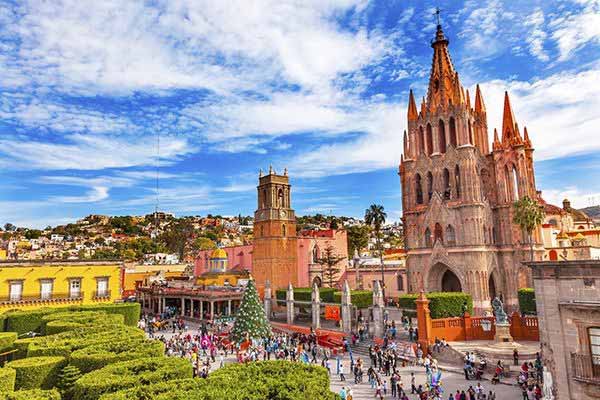
I had been to this charming historic town in the Colonial Highlands region briefly the previous year, visiting on behalf of International Living. It was an in-depth research trip, my days filled with checking out real estate to rent and buy, interviewing expats, walking the streets, checking out the restaurants and cafes…really getting a feel for the place.
That was our starting point. From there, my wife and I started researching online. We made contact with real estate agents and let them know the type of home we were looking to rent. We connected with expats on Facebook, in the San Miguel groups, and asked questions. But unlike with Costa Rica, we didn’t stop there.
That was simply the preparation for getting boots on the ground.
We planned a five-day trip. We picked an Airbnb in one of the neighborhoods in the historic centro that had been recommended. For scouting trips, I always recommend staying in a vacation rental where the “real” people are. It gives you much more of an idea of what it would be like to live there…to wake up and go to the café downstairs…to shop in the local market…and even what the noise levels are like. You can chat with folks in the neighborhood, make contacts that pay off, in not just information but also leads on a long-term rental and recommendations for services you might need in the future like a specialist doctor or attorney. A hotel or resort is too removed from that.
Our schedule on this trip was pretty packed:
- We had two different real estate agents taking us to check out rental listings that fit our budget and needs. Each took about a full day. We wanted to get a sense of average prices, the amenities in each neighborhood, and their distance to the centro.
- We had also scheduled time to check out the local markets and grocery stores, pharmacies, and other shops to see if anything was “missing” that we might need to bring from the U.S. Turns out I needed to bring a backup power cord for my laptop and my wife would have to stock up on an over-the-counter medication she used regularly.
- Because we had some medical conditions in the family that needed regular monitoring, we visited local clinics to see if they had the specialists and equipment necessary.
- We spoke with the directors of the local schools.
- We met up with expats we had connected with online—and took them out for dinner and drinks so we could pick their brain.
We also made time for fun—which is an essential part of seeing if a place is right for you. We visited art galleries, saw a Latin jazz band in a local free concert, and, of course, were sure to follow up on restaurant recommendations…and patronize taco carts long-time residents pointed us to.
We got the information we needed. The community was a good fit for us. We had a rental lined up. Our kids had a reserved spot in school. And we already had friends to meet up with when we moved to town.
But something else unexpected happened that helped us make the final decision. When we first arrived in town, it was also the first day of San Miguel’s patron saint festival. Our online research hadn’t turned that up!
It was several days of parades and processions, fireworks, and music and dancing in the town’s main plaza. It was crowded, noisy, and a whole lot of fun. It was a first-hand experience in the vibrant local culture that showed us just how unique and special life in San Miguel could be.
By the end of the five days, with all the practical considerations good to go…and the lifestyle a match too…we were ready to move.
 Marsha Scarbrough, IL Spain Correspondent
Marsha Scarbrough, IL Spain Correspondent
After I lost everything in the housing crash of 2008, it was clear that I could not afford to retire in the U.S. I had always wanted to live in another country anyway, so the only challenge was deciding which one. I was living in Santa Fe, New Mexico at the time. When the winters turned frigid, I took off in search of the place where I wanted to build my new life. My scouting trips ranged from six weeks to three months. I am an experienced low-budget traveler and love traveling alone.
Throughout my life, I’d spent time in Mexico. It was on my shortlist. I had even lived in Mexico for six months in 2000 at Ajijic on Lake Chapala. Surrounding the lake is an expat community with thousands of Americans and Canadians. I had friends who lived there and enjoyed visiting them, but living there turned out to be different than visiting. I was not comfortable in the expat community where many people did not even try to learn Spanish and looked down on the locals. The many cocktail parties took on a “Groundhog Day” quality. For me, life there was far too predictable and alcohol-fueled. However, it was a valuable experience for helping me profile myself. I learned that expat communities are not for me, but as a single woman, building community with locals and expats was essential.
Another thing I know about myself is that I need arts, culture, and creative people to feel fully alive. Most small towns in remote places don’t fulfill that need. Because I lived most of my life in Los Angeles, I am much happier in a big city. Although Santa Fe is a small city (about 100,000), it is a hotbed of arts and culture. I knew I was looking for a certain creative electricity. Of course, the cost of living had to fall within the limits of my pension income.
Just before I declared bankruptcy in 2009, I took an intensive course to get a TESOL certificate to teach English to speakers of other languages. Starting in 2010, I worked in a summer English immersion program at Santa Fe University of Art and Design. The students were faculty, staff, and graduate students from affiliated universities in other countries like Chile, Peru, Honduras, Mexico, Brazil, and Spain. During my winter scouting trips, I would go visit my former students, with whom I had already begun to build community, in their home countries.
My first scouting trip was to Chile and Argentina (where I had some personal friends). To me, Santiago, Chile had a vibe similar to Los Angeles. I made a couple of new friends. I went on to Viña del Mar, a seaside community where I had several former students. I had a good time. My former students were welcoming, but Viña del Mar seemed too sleepy to suit me. I visited Valparaiso, an artistic city infused with the poetry of Neruda…but with lots of stairs and pretty shaky infrastructure. Chile seemed fine but a bit too bland for me.
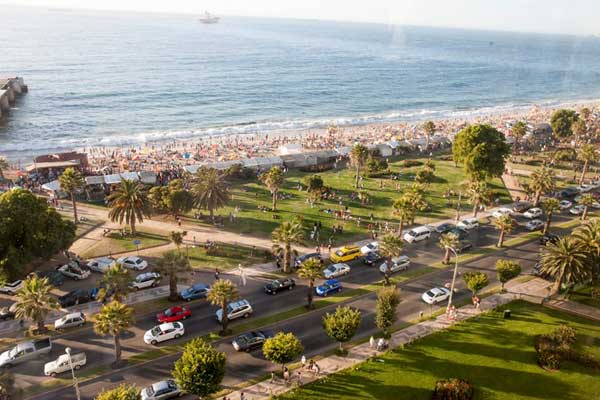
Buenos Aires was an exciting, culture-filled city, for sure. It was also fairly expensive with inefficient public transportation. I love to dance and took some tango lessons. I learned that tango is not my dance. I went on to Salta, Argentina to see my friends. It’s a sunny, high-altitude city with an aesthetic similar to Santa Fe. I loved the surrounding landscapes and the connection to indigenous culture. However, it’s still a small city, and I knew it would only hold my interest for a short time. I crossed the Andes to Mendoza, where I indulged in Malbec and took some winery tours, but the city itself seemed cold to me. Argentina was not particularly cheap, and its history of political and financial instability was concerning.
My next scouting trip was to Brazil, which was wonderful and wild. I started out in Copacabana in an Airbnb with a young host who introduced me to all his friends. I took Portuguese classes in Ipanema. A young architect invited me to stay with her in the idyllic beach town of Paraty. My host’s mother invited me to visit her in the mountain town of Petrópolis. I visited former students in the overwhelming concrete jungle of Sao Paulo. I made my way to Salvador, Bahia where the African culture captured my heart. I considered settling there but moved on to celebrate carnival in Recife, then visited former students in Natal, another seductive beach town. Salvador was on my list, but ultimately Brazil was too expensive, and frankly, dangerous.
Another trip took me to Guatemala, Honduras, and southern Mexico. The city of Antigua in Guatemala rose to the top of my list. It had the artistic energy of Santa Fe mixed with indigenous Mayan culture. It was inexpensive. The expat community was small. Community with locals seemed possible. I was willing to compromise on infrastructure and safety for everything else it had to offer. Then…
In 2016, I visited Spain. I’d put it last on the list because I assumed, since it’s in Europe, it would be too expensive, but I wanted to visit a former student who had become a good friend. Alberto is a fine arts professor and performance artist. We had become friends in the English immersion. When he came back the next year as a visiting professor, we really got to know each other and traveled together in New Mexico and Texas. Alberto lives in Madrid, and he showed me that city’s beauty and shadows. He introduced me to his artist friends. He took me to Sevilla to meet his parents. Sitting in the garden of Sevilla’s Alcázar, having coffee with my friend, enjoying the shade on a sunny day, gazing at flowers, listening to birdsongs and splashing fountains, I thought “this is what I am looking for.”
I went on to Granada on my own. I was dazzled by the Alhambra and the Moorish romance of the old quarter. Walking through those ancient streets, I thought, “I should check on rental prices. I could live here.” I visited Barcelona, Cordoba, and Cadiz. I went back to Madrid then spent a week volunteering at Pueblo Ingles, an English immersion program in the mountains near the Portuguese border. In that intense week of conversations, shared meals, and laughter, I made friends with other Spanish people. When I got back to Madrid, I went out on the town with those friends. When it came time to return to the U.S., I thought, “I could live here.” I realized that it had been easy for me to make friends. I had experienced the creative electricity of the art scene. The cost of living was low enough to work for me. The weather and flora were like the California of my youth.
On the trip back, I had a seven-hour layover in Dallas airport where I contracted some of the worst food poisoning of my life. When I finally fell into my bed, I thought, “if ever the Universe gave you a sign, that was it. Life in U.S. makes you sick. Move to Spain.” Nine months later, in 2017, at the age of 70, I got my visa and never looked back. Moving to Spain is one of the best decisions I have ever made. It is still easy to make friends, and I have found the community I was seeking.
The scouting trips were valuable. Too many intangibles create the feelings that make a certain place seem like home. You can’t feel your personal connection by reading about a place or watching travel videos. You have to put yourself into the mix and have your own experience. I recommend spending at least six weeks in any country you are considering.
WIN YOUR DREAM RETIREMENT OVERSEAS
 David Hammond, IL Uruguay Correspondent
David Hammond, IL Uruguay Correspondent
My initial attraction to Uruguay was real estate. It’s a country where you can buy and own property with the same rights and protections as a local citizen. And most real estate in Uruguay is bought and sold in U.S. dollars.
So, in May 2006, I visited Uruguay for the first time to look at investment property. I stayed in Punta del Este, where I found a world-class beach resort, affordable apartments, and a robust vacation rental market. I also met reputable property managers with experience working with foreign owners.
West of Punta del Este is Uruguay’s Rocha Department. It’s a mostly-rural region with pristine Atlantic coast beaches where I found affordable building lots.
Besides exploring along the coast, I drove inland. Uruguay’s interior is part of the South American Pampas, a vast region of fertile plains used for cattle grazing and farming.
I’d planned to stay in Uruguay for two weeks. But as the end of my trip approached, I didn’t want to leave. In that short time, I’d developed a fondness for the place.
Uruguay’s natural landscape relaxed me. I appreciated my interactions with the locals. (For my tastes, Uruguay’s culture possesses the perfect blend of warmth and politeness.) And the low cost of living got me calculating how much further my money could go.
I pictured starting a new life in Uruguay, with fewer bills and more free time to dust off some old dreams (like writing).
So, I canceled my return flight. And I spent another two weeks investigating Uruguay as a place to live.
I confirmed I qualified to become a resident. And I picked the brains of English-speaking locals who’d lived in the U.S. for a time and returned. So, they understood what I was coming from and could explain some of the contrasts in how things work.
(Why didn’t I talk to expats? While you find a lot of expats from the U.S. in Punta del Este now, you didn’t at that time.)
Before I returned to the U.S., I made an offer on an apartment and opened a bank account. Six months later, I was back in Punta del Este to give living in Uruguay a nine-month trial. 14 years later, I’m still here.
During this time, I’ve met many people from the U.S. who’ve moved to Uruguay. For most, a scouting trip was a step in the process. It enabled them to get a true feel of the place with all its nuances before making a decision.
Are you considering a move abroad? If so, I offer the following tips for planning and undertaking your own scouting trip.
Scouting Trip Planning Tips
1. Take Advantage of Pre-trip Research and Planning Resources
Nowadays, you find a lot of helpful resources to learn about a country and plan a scouting trip. These include:
- Travel guides
- International Living’s country guides (which include lists of in-country contacts)
- International Living‘s sample scouting trip itineraries
Also, you can write to International Living’s in-country correspondents with specific questions.
2. Check for Potential Relocation Deal Breakers
Use your pre-trip research and planning resources to make a preliminary check for things such as:
- Is the cost of living in line with your budget?
- Do you meet the basic residency requirements?
- Does it seem likely you’ll be able to access good medical care?
- Are the tax implications for your personal situation acceptable?
3. Decide on the Best Time of Year to Visit
Are you concerned about a potential seasonal challenge? If so, you might visit during that time of year to determine things like:
- Will the rainy season affect my mood?
- Will winter be too cold?
- Can I live with the summer crowds?
If you don’t harbor such a concern, consider scheduling your visit during a shoulder season. It’s often a time of year when the weather is still pleasant and hotels and rental cars cost less.
4. Be a Prepared International Traveler
Learn:
- What clothes will be appropriate for the season and culture?
- The exchange rate for the local currency
- The local electrical current and electric outlet configuration
- Some basic customs
- Local tipping practices
If you don’t speak the local language:
- Select accommodations with English-speaking staff
- Learn a few common phrases
- Familiarize yourself with a smartphone translating app
5. Build Flexibility Into Your Itinerary
Include some cushion in your schedule for rainy days, rest and laundry days, and to enjoy some attractions and side trips along the way.
Scouting Trip Travel Tips
1. Investigate “Must-Haves” Before “Nice to Haves”
For example, if you need to be near a hospital with a cardiology department, confirm that before spending days looking at apartments.
2. Take Pictures and Notes Along the Way
This will help you sort out the details when you look back on your trip to review your options and make comparisons.
3. Talk With Expats From Your Home Country
Ask about their experience making the move and getting set up. Also, ask about the cultural differences you can expect to encounter.
If you’re in an area with few expats, seek locals with experience living in your home country. (That’s what I did.)
4. Arrange to Meet a Local Relocation Specialist
Such a meeting can serve to:
- Learn more about the specific steps and time frame to become a legal resident
- Determine if you and the relocation professional seem like a good match
- And if so, get references to check before making a hiring decision
5. Look Closely at Healthcare
The availability of competent medical care can be a matter of life and death. So, before you choose a place to settle, confirm your eligibility for a local healthcare plan. Check the healthcare organization’s capabilities. Confirm the costs. And talk to expats with that same health plan to learn their experiences.
For many expats, quality healthcare at a lower, predictable cost is one of the top benefits of living abroad.
6. Be Open to New Possibilities
Your scouting trip might turn up interesting lifestyle possibilities you hadn’t considered.
That’s how it was for me. I came to Uruguay for a real estate investment. But, I stayed for the lifestyle, which includes lower costs, less stress, and more free time for creative endeavors.
 Terry Coles, IL Portugal Correspondent
Terry Coles, IL Portugal Correspondent
The decision to retire abroad is no easy task and for most requires hours of research using publications like International Living, expat blogs, or following social media groups. For those whose budget allows, they may travel to one or more countries to experience firsthand what living there might be like. Others who have already traveled the globe may be more eager to jump into life abroad without much hesitation. But for most of us, moving abroad can be both terrifying and wonderful.
Back in Texas we were living the “American Dream” like so many others, just getting by from one paycheck to the next with no money to spare. Clyde worked as a firefighter and paramedic in Corpus Christi for nearly 30 years but always dreamed of retiring at age 57, when I was just 51. I worked in medical offices but, unlike Clyde, never managed to find a job that I really loved. So, when Clyde asked me if I would be willing to move out of the U.S. in order to live comfortably on his pension I said, “Where we are going and when?”
And believe it or not, neither Clyde nor I had ever even been out of the U.S. before, which makes our story even more incredible.
Our first adopted country was Panama. On our first exploratory trip we rented a car and drove from one end of the country to the other chatting to expats along the way. After just one visit we returned to the U.S. determined that we could and would be able to make this work and began the process of selling our house to prepare for our dream retirement abroad. Once we freed ourselves of our house, cars, and excess stuff, we needed to decide where we wanted to live in Panama but could not afford another visit. After a few months of searching online, Clyde found a three-bedroom, two-bath house for rent one hour from Panama City in the village of Capira. Although we knew absolutely nothing about the area, we rented the house sight unseen for just $300 a month. Yes, we were really going to do this!
We enjoyed life in Panama for five years, bought a house, and had a ton of friends until one day I convinced Clyde to take our first ever trip to Europe. After a one-month trek through five different countries we returned to Panama as changed people. Europe had infiltrated our hearts and minds and we knew that it was time to move on, but to where? We sold our Panama house with everything in it and walked away with just two carry-on-sized suitcases each. For the next two years we traveled rent-free as international house and pet sitters, living a nomadic life. It was from a house sit that we discovered Portugal and decided to adopt this as our next home.
Our Portugal scouting trip began in the southern region called the Algarve. A popular expat haven with a long history of British tourists, expats here can get by speaking little to no Portuguese, which seemed perfect to us. But rental prices were high, and our budget was low, so we opted to look elsewhere. A friend suggested we check out Caldas da Rainha, a mid-sized city on the Silver Coast in the center of the country. Just a one-hour drive north of Lisbon, we landed a three-bedroom, fully furnished private home for only $410 a month. Our house was a ten-minute drive from the center of town and offered us spectacular views overlooking the countryside. The city of Caldas had much to offer with its large expat community, a cobbled downtown, modern shopping mall, a public and private hospital, gyms, a bowling alley, and more.
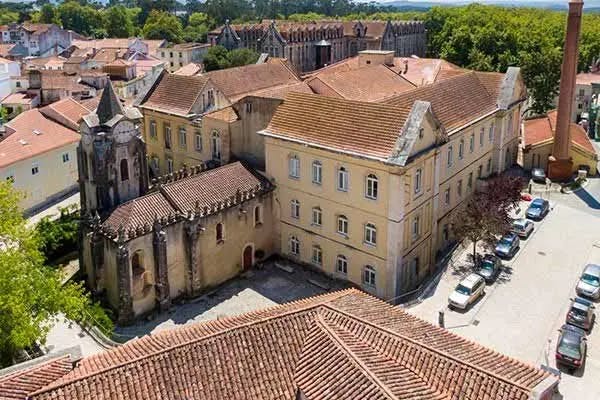
Our must-haves for a place to live included: being close to an expat community for support and friendship, good hospitals and medical clinics, a gym, easy access to an international airport, and affordable living. Caldas had all of this and more. Also, we had decided that if we were going to live in Portugal, we did need to learn the language, something I was against at first. Being able to speak and understand the local lingo, we discovered in Panama, is not only a sign of respect but essential to make daily life easier. Plenty of Portuguese do speak some English but there have been times when no English speakers were to be found, leaving us feeling lost and stupid.
After two years of the cold and dampness of the Silver Coast we decided to move three hours south and settle into the Algarve. Living in Panama for five years with no air conditioning has ruined us to cold temperatures, and while plenty of expats love central Portugal, it was too cold for us.
My advice for anyone looking to move abroad is this: Ask yourself plenty of questions about what you really want and need to be happy. What is your budget? Do you want to live in an apartment or house, with or without a car? Do you need to wake up to the sound of the ocean or see mountain vistas? What type of climate do you need to be happy? Is having an expat network important to you, or do you hope to become immersed in the local culture? Do you have extenuating health conditions that require you to be close to specialty hospitals and clinics? Can you live without your favorite brand of peanut butter, shampoo, or designer labels?
It has now been TEN years since Clyde and I said goodbye to all that was comfortable to us in the U.S. to jump headfirst into the unknown. We have lived in or visited over 40 countries around the world and have never once regretted our decision to move abroad. Pretty amazing for two people who had never traveled out of the U.S. before.

Get Your Free Report on the World’s Best Places to Retire:
Learn more about the best places in the world to retire in our daily postcard e-letter.
Simply enter your email address below to sign up for our free daily postcards and we’ll also send you a FREE report on The World’s Top 10 Retirement Havens, plus access to over 10 more free reports. Our gift to you, on our favorite destinations.
Related Articles
The World’s Best Places to Retire
5 Best Caribbean Islands to Live On… and 2 to Avoid
5 Great Places to Retire Where it’s Easy to Fit In
Upcoming Conferences
Most Popular Products
Panama 101
Portugal 101
Costa Rica 101

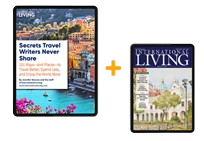

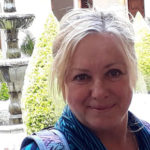 Donna Stiteler, IL contributor in Cuenca
Donna Stiteler, IL contributor in Cuenca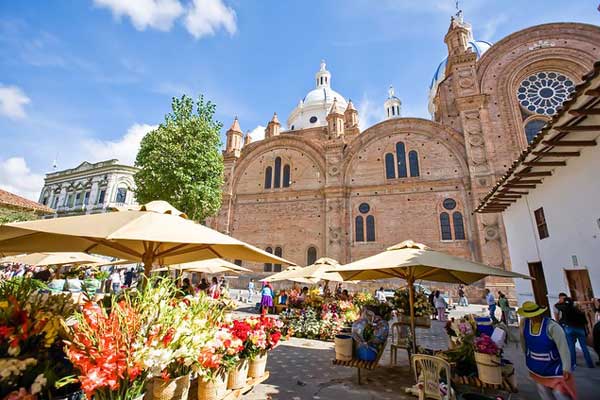
 Kathleen Evans, IL contributor in Costa Rica
Kathleen Evans, IL contributor in Costa Rica
 Laura Diffendal, IL contributor in Belize
Laura Diffendal, IL contributor in Belize Valerie Fortney-Schneider, IL Italy Correspondent
Valerie Fortney-Schneider, IL Italy Correspondent Jason Holland, IL Roving Latin America Editor
Jason Holland, IL Roving Latin America Editor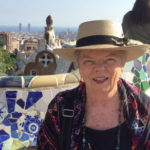 Marsha Scarbrough, IL Spain Correspondent
Marsha Scarbrough, IL Spain Correspondent David Hammond, IL Uruguay Correspondent
David Hammond, IL Uruguay Correspondent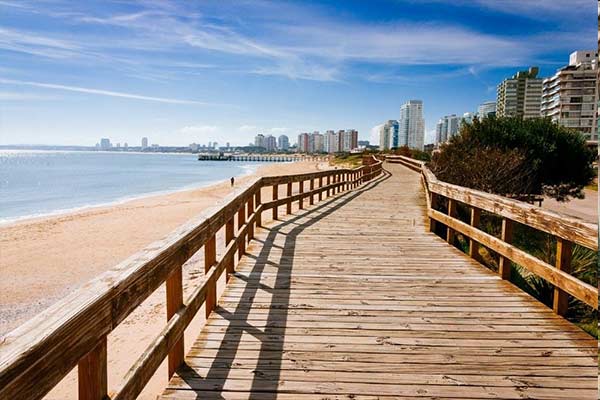
 Terry Coles, IL Portugal Correspondent
Terry Coles, IL Portugal Correspondent